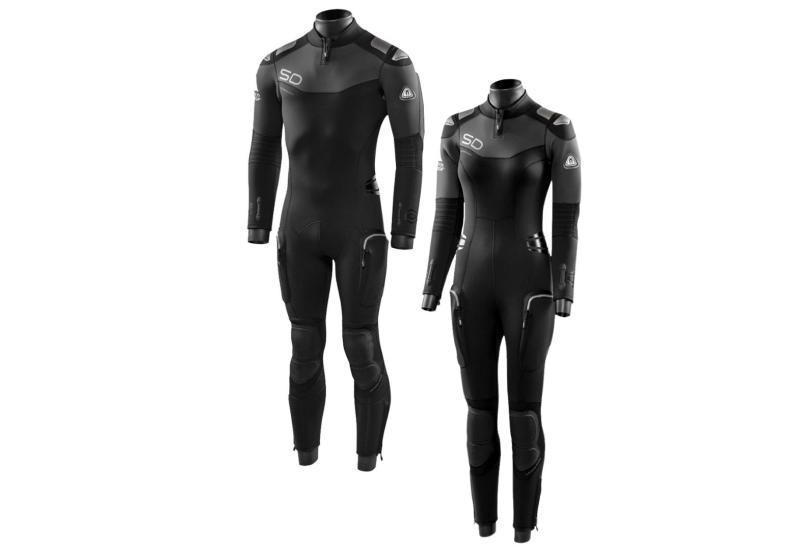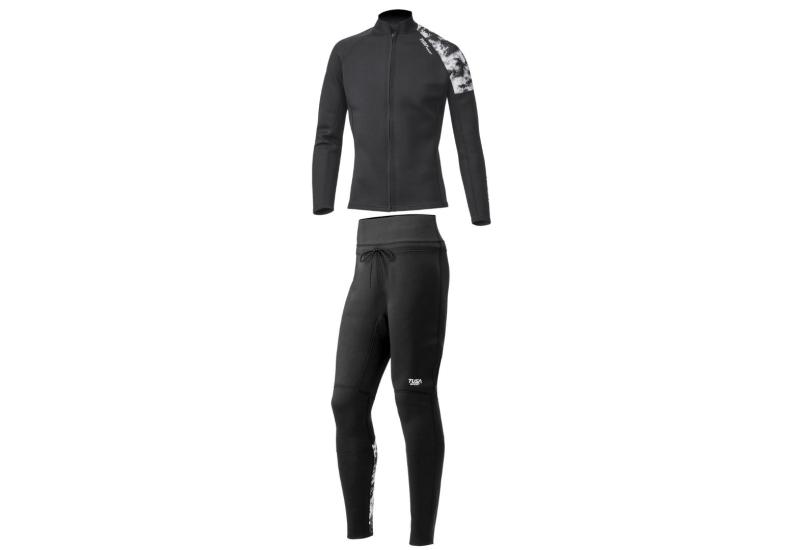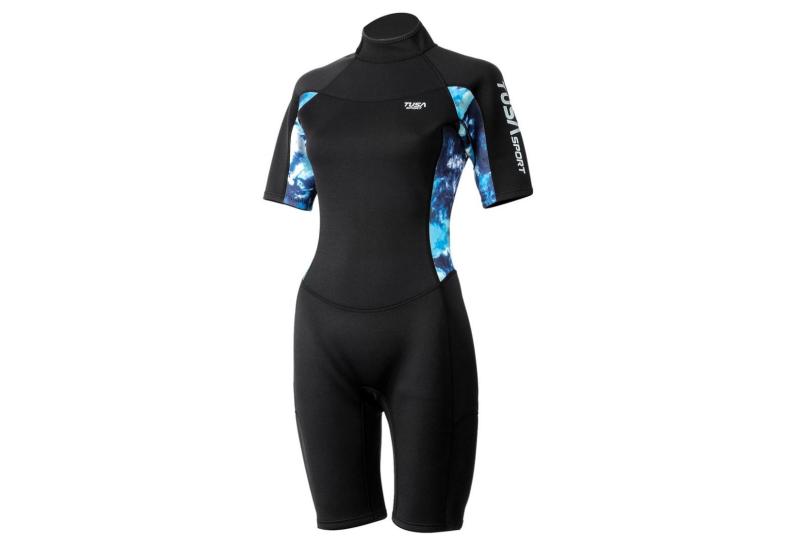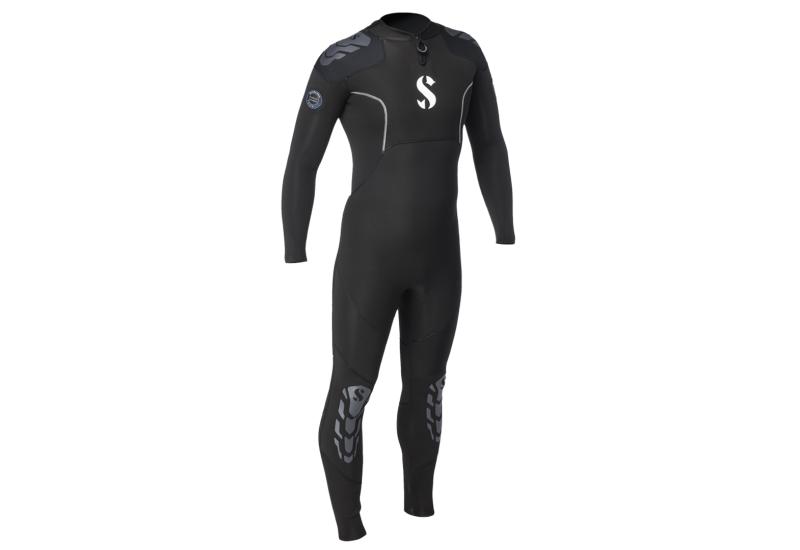Cut & Dry: 13 Dry Suits for Under $1,000
April 2002
By John Brumm
Dry Suits Reviewed in This Article
| BARE SPORTSWEAR D7 SUPRA DRY BARE SPORTSWEAR NEX-GEN DRY DUI CNSE DUI TLS350SE HENDERSON ARCTIC DRY II OCEANER HORIZON OCEANER TITANIUM POLAR | O'NEILL 7000X O.S. SYSTEMS DOLPHIN USIA AQUALITE WHITES NEXUS SHELL SUIT WHITES NEXUS NEOPRENE VIKING'S X-TREME |
Why dive in a dry suit?
Why indeed. They cost more than wetsuits. They require that you modify your buoyancy control skills and add extra oomph to your fin kick. You have to deal with undergarments, and there's a good chance you'll need to buy fins with larger foot pockets to accommodate dry suit boots. Then there's the maintenance thing, with the valves and the watertight zippers and the neck and wrist seals.
So why dive in a dry suit?
Simply because nothing beats being this warm under water.
With a dry suit, it doesn't really matter how cold the water is or how deep you dive because you can regulate your at-depth comfort either by varying your thermal protection--the colder the water, the thicker the undergarments, or by adding air to the suit. It doesn't really matter how cold topside temperatures are either, because when you exit the water, you're often wearing the equivalent of fuzzy pajamas instead of a soppy wetsuit. In short, in a dry suit, sport diving becomes year-round entertainment.
TYPES OF DRY SUITS
The dry suits reviewed here fall into three categories: foam neoprene, fabric and "hypercompressed" neoprene.
Foam neoprene wetsuits. Like wetsuits, their thermal protection comes primarily from the neoprene itself. They are high-stretch, tend to fit snug because they require few or no thermal undergarments, and they lose less of their buoyancy if flooded. However, foam neoprene dry suits compress at depth, which diminishes their thermal properties. Neoprene is also the most buoyant of all dry suit materials and thus requires more ballast weight. It used to be that foam neoprene dry suits were substantially lower in price than fabric suits--a major selling point--but this is no longer the case.
Shell suits. Fabric or "shell" suits are constructed of nylon outer layers either coated or laminated with urethane or rubber. The result is a lightweight composite with no inherent buoyancy that doesn't compress at depth. Fabric suits are designed solely to keep water out; thermal protection is achieved through the use of undergarments. But to accommodate these undergarments, fabric suits require a looser fit. This results in a somewhat bulky feel to the suit which, at least theoretically, creates more drag in the water. The additional material is also needed to increase your range of motion because fabric suits don't stretch.
Hypercompressed neoprene suits. Hypercompressed (not crushed) neoprene dry suits take the best of both foam neoprene and fabric designs by providing a rugged, high-stretch, snug fit with minimal inherent buoyancy. Like shells, these suits are meant to be worn over thermal undergarments.
HOW WE TESTED THEM
Scuba Lab's dry suit test regimen was designed to focus on suit functions that are important to the broad range of recreational divers. These functions include:
-
Donning and doffing. The ease or difficulty of getting in and out of the suits.
-
Range of motion. How well you're able to move while wearing the suit, both under water and on the surface.
-
Valve positioning. On the upper left arm, near the shoulder, facing upward, tends to be standard.
-
Valve use. The ease of operating both inlet and exhaust valves.
-
Valve flow rates. The ability of the exhaust valve to flow air out of the suit faster than the inlet valve can put it in.
-
Quick disconnect. The ease of removing or attaching the hose to the inlet valve while at depth in the event of a valve malfunction.
-
Air shifting. The tendency of air to shift in the suit, particularly to the boots, adversely affecting control.
-
Boot-top interference. If the boot binds or rubs to inhibit ankle flexing, fin kick will lose efficiency.
-
Hydro drag. The degree to which water resistance is noted.
-
Inherent buoyancy. Related to how much ballast weight is required to achieve neutral buoyancy.
Field Notes
-
Fit Matters. Air shifting and range of motion problems are both functions of fit. Get the right-sized suit and these problems virtually disappear.
-
Dry suit drag. It's been said that foam neoprene dry suits produce less drag than fabric suits. Putting both suit styles in the water--without dive gear--seems to bear this out. But of course divers don't dive without dive gear, which creates more drag than anything generated by the suits themselves.
-
Where's the zipper? Dry suits are available with a variety of zipper positions and self-entry designs. However, dry suits falling into the price category featured in this review are available only as shoulder entries.
-
Valve position. While all inlet valves tend to be uniform in their center-chest locations, the positioning of exhaust valves varies slightly. On dry land it's hard to notice, but once you hit the water it becomes clear that a valve placed too far forward on the arm, more on the bicep than on the top of the upper arm, can affect its performance because in the normal swimming attitude the valve is not in the highest possible position.
-
Swivel inlet valves. No dry suit should be without one. They make it so much easier to comfortably route your inflator hose, and they eliminate the need to loosen and retighten the inlet valve backing nut (to reposition the hose nipple of a nonswivel valve), which could affect the seal.
-
Choose your boots. The durability of attached boots varies widely. Some boots, while adequate for boat decks, are simply not up to the rigors of shore diving. Have a clear idea of your diving goals before choosing your boots.
-
Skin is in. Most foam neoprene dry suits come with neoprene seals with the smooth "skin" layer on the outside. To get a proper seal it's necessary to fold the neoprene under so the seal's "skin" is against your skin. Otherwise, prepare to be wet.
Fabric vs. Foam Neoprene: Unfair to Compare
For this evaluation, dry suits basically have been divided into two categories: "foam neoprene" and "fabric." The test team felt this was necessary because tests consistently showed that foam neoprene dry suits:
-
Are harder to get into and out of than fabric suits.
-
Generally require more ballast weight to achieve neutral buoyancy than fabric suits.
-
Tend to be damp around seals and in some cases around valves. (Not one neoprene suit tested was able to keep test divers completely dry. At best, there was minor seepage around neck and wrist seals.)
Consequently, we found that foam neoprene suits are able to strut their stuff only if they have the testing stage to themselves. Let a fabric suit get on that stage with them and foam neoprenes don't stand a chance. In short, when it comes to ease of use and the ability to keep a diver dry and comfortable at depth, foam neoprene dry suits, during our tests, simply were not able to keep up.
Still, there are many divers out there who feel foam neoprene dry suits are more resistant to punctures and abrasion, provide a more hydrodynamic profile and are more comfortable because they stretch.
FABRIC DRY SUITS
BARE SPORTSWEAR NEX-GEN DRY: Comfort and Performance

Bare's Nex-Gen Dry shell suit earned good to excellent test scores in both comfort and valve performance. A partial elastic (nonadjustable) internal waist panel improves fit; bottleneck-shaped neck and wrist seals make donning and doffing easy while keeping water out, and the attached 4mm neoprene soft socks are about as comfy as they come. All suit seams are sewn, then welded. Knees are reinforced with big 420-denier nylon patches.
The swivel inlet valve provides excellent airflow control. The exhaust valve offers two full revolutions of adjustment. It's positioned a little higher than exhaust valves on other dry suits we've reviewed, which seems to contribute
The soft socks are designed to be used with Bare's optional Trek boots. These boots are extremely flexible and provide good ankle support. While the heavy tread is designed for rocky entries as well as boat decks, we found the soles to be a little slippery on metal dive ladders. Trek boots come in black and sell for about $90 a pair.
Material: "Nex-Gen" welded fabric.
Seals: Latex.
Swivel inlet: Yes.
Color: Black.
Sizes: 9 men's, 4 women's, stock sizes only.
Price: $749.95, includes: Suit, neoprene soft socks, valves, inflator hose, knee pads, zipper lube, talc and bag.
Strengths: Easy to don and doff. Excellent valve flow rates. Good owner's manual.
Weaknesses: Trek boots slippery on metal dive ladders.
DUI TLS350SE: Comfortable and Durable

The only trilaminate dry suit in this group and deemed the favorite fabric suit among test divers, DUI's TLS350SE is extremely comfortable. The additional inner layer of nylon not only helps to protect the waterproof layer, but it creates a smooth surface that makes it easier to slip the suit over undergarments. The suit comes with an internal adjustable waist cord and an extra layer of nylon in the thigh, knee and shin areas. The attached socks are made of supple soft-dipped neoprene, enabling you to turn the suit inside out for drying. Neck and wrist seals are cone-shaped, which DUI feels will accommodate a wider range of neck and wrist sizes while still providing plenty of rubber to contact the skin for a good seal.
Both valves produce efficient air flow. The inlet valve's action allows for fine-tuning. The low-profile exhaust valve is well-positioned for automatic activation. A flanged quick-disconnect fitting on the inlet hose is easy to grip. The hose itself is about four inches longer than other dry suit hoses, which makes it easier to route.
At the price listed here, the TLS350SE comes with soft socks that can be worn inside standard (albeit oversized) dive booties. However, for a few extra bucks, the TLS350SE can be ordered with attached boots, or better yet, with DUI's separate Rock Boots. Although primarily designed for hiking over rocks to reach dive sites, these rugged boots provide ankle support as well as great traction on slippery boat decks and dive ladders. They sell for about $40.
The TLS350SE is now available in women's sizes, designed with shorter arms, narrower shoulders, a tapered waist, more hip and thigh room, and smaller feet.
Material Nylon/butyl rubber/nylon.
Seals Latex.
Swivel inlet Yes.
Colors Blue/black for men; purple/black for women.
Sizes 5 men's, 5 women's, stock sizes only.
Price $998; includes: suit, valves, inflator hose and dipped neoprene socks.
Strengths Easy to don and doff. Responsive inlet valve. Low-profile exhaust valve. Easy-to-use quick-disconnect hose fitting. Good valve flow. Excellent owner's manual.
Weaknesses None.
O.S. SYSTEMS DOLPHIN: Nice Workmanship

O.S. Systems' Dolphin is a well-constructed shell suit with quadruple stitching throughout and a reinforcing layer of nylon in the knee areas. Holes along the boot cuff are provided to drain water from between these "dome" knees and the suit itself. The suit is roomier than some other comparatively sized shell suits. An internal, nonadjustable waistband helps improve fit. Wrist and neck seals are bell-shaped. The Dolphin's vulcanized rubber boots are very comfortable, providing excellent flex, although they're not as rugged as other dry suit boots. They'd be fine for boat decks but probably wouldn't last long climbing over rocks.
Both inlet and exhaust valves are in optimum positions. The inlet valve swivels easily. The exhaust valve is larger than most but isn't cumbersome. The quick-disconnect hose fitting is not flanged but detaches adequately. Upgrade options are limited to footwear and valve choices. Boot sizes range from 4 to 14 and are easily interchangeable.
Material 210-denier high-count nylon.
Seals Latex.
Swivel inlet Yes.
Color Black.
Sizes 6 unisex, stock sizes only.
Price $999; includes: suit, valves, inflator hose, attached boots, zipper lube, repair patches, bag.
Strengths Easy to don and doff. No boot-top interference. Good valve position and operation. Good valve flow.
Weaknesses Owner's manual provides minimal information.
USIA AQUALITE: A Rainbow of Colors

Nobody does color like USIA. Its AquaLite shell offers more accent choices than any other dry suit tested. It also provides the baggiest cut of all shell suits tested. An internal nonadjustable waistband helps rein in the additional material. Double stitching can be found along the zipper with double or triple stitching everywhere else. Soft-soled boots are standard equipment. (Sized for the U.K., they're one size larger than U.S. sizes.) They're easy to strap a fin to, but don't look like they could handle much more than a boat deck. Hard-soled boots are available as an option. All suits come with protective boot cuffs.
The inlet valve doesn't swivel, but can be repositioned by loosening then retightening the backing screw (a swivel inlet valve is available as an option for $15). The inlet valve button is hard to activate. The exhaust valve is well-positioned and flows air well. The valve is tall but dome-shaped so it's less likely to catch on gear.
With the AquaLite, you can choose among a number of packages and still stay below $1,000. For $949, you can get the suit listed above plus a neck ring, a two-sided carry bag, a maintenance kit and a pair of USIA's Exotherm I undergarments. For another $50 you get the heavier Exotherm II undergarments.
Material 210 nylon twill, urethane-backed.
Seals Latex.
Swivel inlet No.
Colors Black with blue, pink, lime, purple, yellow, teal, orange or red accents.
Sizes 7 unisex, stock sizes only.
Price $899; includes: suit, valves, inflator hose, attached boots, zipper lube.
Strengths Easy to don and doff. Good owner's manual. Good valve flow. Good valve positioning. No boot-top interference.
Weaknesses Inlet valve doesn't swivel. Stiff inlet valve action. Extra bulky fit.
WHITES NEXUS SHELL SUIT: Good Suit, Great Price

Good performance combined with the lowest price of all dry suits tested earned Whites' Nexus Shell both Testers' Choice and Best Buy designations. The suit comes with bell-shaped latex seals, bilaminate soft socks, suspenders and a partial elastic waistband. One of the best fitting shell suits, its almost tapered cut provides such a snug fit that when it comes to sizing, you'll probably want to err on the large side, especially if you normally alternate from thin to thick undergarments.
The same goes with Whites' optional Evolution boots, which are more flexible than DUI's Rock Boots and fit much easier into standard fin foot pockets. But while Rock Boots are cut big to accommodate insulated footwear and soft socks, Evolution boots are cut closer to standard shoe size. During tests, a size 10 Rock Boot was able to comfortably accommodate insulated footwear and suit socks, whereas a size 11 Evolution boot on the same foot wearing the same footwear and suit socks caused some serious toe cramping. Evolution boots cost $80 if ordered with a Nexus suit, $100 if purchased separately.
Although both inlet and exhaust valves are well positioned and operate efficiently, the fact that the inlet valve doesn't swivel is a disappointment on what is otherwise an exceptional suit. The Nexus Shell includes an ID-ROM that provides instructions on dry suit use and maintenance.
Material 420-denier bilaminate.
Seals Latex.
Swivel inlet No.
Color Black.
Sizes 12 unisex, stock sizes only.
Price $678; includes: suit, valves, inflator hose, knee pads, zipper lube, bag, instructional ID-ROM.
Strengths Low price. Lots of sizes. Easy to don and doff. Suspenders. Good valve positions and operation. Good valve flow rates.
Weaknesses Inlet valve doesn't swivel.
VIKING'S X-TREME: Built Tough

The first thing that strikes you about Viking's X-Treme is how bulletproof the suit appears. Constructed of a polymer-coated fabric with welded seams, the suit offers extra-thick cone-shaped latex seals, large heavy-duty knee pads and rugged yet very flexible chloroprene-coated boots. Suspenders are standard, a nice touch. So is the attached Surveyor hood, although this is an acquired taste. Depending on how much facial hair you have, it can be difficult to get a proper seal. Viking says the hood is available in smaller sizes to accommodate divers with smaller heads. However, the trim of the hood opening is critical to achieving seal success. Although Viking prefers selling its X-Treme with the Surveyor hood attached, you can order the suit with a latex neck seal only for the same price or with an attached neoprene hood for an additional $50.
The X-Treme's inlet valve works efficiently, but the exhaust valve needs some coaxing. The consensus during testing was that the position of the valve on the bicep makes it necessary to manipulate the valve to help it bleed air. On the other hand, the flanged quick-disconnect fitting on the inlet hose is clearly the best of the bunch. Not only is it large, making it easy to grip, but you don't have to pull back on the flange to attach hose to valve. Simply press it to the valve nipple and it snaps right on.
The X-Treme is available in "X-Treme Wide" sizes to accommodate larger chests and shoe sizes.
Material Polymer-coated fabric.
Seals Latex.
Swivel inlet Yes.
Colors Black, blue/black. Sizes 5 unisex, "wide" sizes available.
Price $950; includes: suit, valves, inflator hose, suspenders, attached hood, attached boots, repair kit, bag.
Strengths Excellent hose quick-disconnect. Good inlet positioning and operation. Removable suspenders. Excellent owner's manual.
Weaknesses Exhaust valve position and operation. Difficult to achieve hood seal. {mospagebreak}HYPERCOMPRESSED NEOPRENE DRY SUITS
DUI CNSE: Leader of the Pack

The overall favorite dry suit among Scuba Lab's test team, DUI's CNSE falls into a category of its own. Constructed of heavy-duty nylon over 1.5mm hypercompressed (not crushed) neoprene, the CNSE not only fits like a glove, but it provides more stretch than fabric suits while sidestepping the buoyancy problems of traditional foam neoprene suits. It's an extremely comfortable suit that comes with an internal adjustable waist cord that improves upon an already snug fit. A pair of beefy knee pads provide additional protection for the bottom scratchers among us.
Like its cousin the TLS350SE, the CNSE's valves are well-positioned on the chest and upper arm. The inlet valve delivers smooth action while the exhaust valve's low profile makes it easier to slip under BC straps. The suit comes with an extra-long inlet hose equipped with an easy-to-use quick-disconnect fitting and is designed to be worn with DUI's optional Rock Boots (see "TLS350SE").
Both the CNSE and the TLS350SE come with what's arguably the most comprehensive dry suit owner's manual in the industry. These consumer-oriented manuals are not only invaluable for DUI dry suits, but the information and instructions on boot use, valve maintenance and general dry suit diving techniques can easily be applied to any dry suit or dry suit diving situation.
Material Hypercompressed neoprene.
Seals Latex.
Swivel inlet Yes.
Color Black. Sizes 5, stock sizes only.
Price $998; includes: suit, valves, inflator hose, knee pads, dipped neoprene socks.
Strengths Easy to don and doff. Pliable material. Responsive inlet valve. Low-profile exhaust valve. Easy-to-use quick-disconnect hose fitting. Good valve flow. Excellent owner's manual.
Weaknesses None.
FOAM NEOPRENE DRY SUITS
BARE SPORTSWEAR D7 SUPRA DRY: Sizes Galore

The D7 Supra Dry is available in six stock sizes, but if you can wait a few weeks for delivery, you can increase your choice of sizes more than twofold. The suit's 6mm "high density" neoprene is sandwiched between Diamond Tuff nylon and a "heat-reflective" Metalite lining. All seams are double-glued and heat-taped. Both inlet and exhaust valves produce efficient airflow.
The test suit was delivered with reinforced knee pads and attached vulcanized 7mm neoprene boots that are rugged but surprisingly flexible. However, those who prefer separate boots can order the suit with attached soft socks and Bare's Trek boots.
The D7 Supra Dry is the only foam neoprene dry suit recently tested with bottleneck-shaped latex wrist seals. The latex is very thick and doesn't stretch much, but with proper trim and the help of talc, it provides a relatively comfortable watertight seal. The extra-long neoprene neck seal allows for a fold-over skin-in seal but bulks up the neck area, creating a fit that's not as comfortable as previously tested neoprene dry suits. A cold-water collar is standard.
Material: 6mm neoprene/nylon.
Seals: Neck, 3mm neoprene; wrists, latex.
Swivel inlet: Yes.
Colors: Blue/black.
Sizes: 6 men's, 4 women's, custom sizing available.
Price: $899.95; includes: Suit, valves, inflator hose, attached boots, knee pads, zipper lube and talc.
Strengths: 15 semi-custom sizes. Highly adjustable exhaust valve. Heavy-duty attached boots. Good owner's manual.
Weaknesses: Uncomfortable neck seal design.
HENDERSON ARCTIC DRY II: Super Stretch

In last year's dry suit reviews, Henderson's Arctic Dry II foam neoprene dry suit earned a Best Buy designation for its great price. This year, a new swivel inlet valve and a low-profile exhaust valve contributed to the Arctic Dry II also being named a Testers' Choice.
Thanks to its stretch and range of motion, this comfortable suit was repeatedly compared by testers to wearing a wetsuit. Ankles are tapered, and the soft boot uppers combined with a hard sole create a snug boot with lots of flexibility and less stiff rubber to stuff into a fin pocket. The Kevlar knee pads are excellent, and the wrist seals are neoprene out/skin in, eliminating the need to fold them over to attain a seal.
Just like wetsuits, neoprene dry suits can be difficult to climb in and out of. Because of its flexibility, the Arctic Dry II is easier to don and doff than most other neoprene suits, especially when a splash of unscented talcum powder is applied to the skin-in seals.
Valve flow on the Arctic Dry II is very good. The inlet provides efficient air control and the exhaust valve dumps air fast. Henderson has dropped separate women's sizes for 2002.
Material 7mm foam neoprene.
Seals Neoprene.
Swivel inlet Yes.
Colors Blue/black. Sizes 6 unisex, stock sizes only.
Price $729; includes: suit, valves, inflator hose, knee pads, attached boots.
Strengths Low price. Flexible body. Soft boot uppers with heavy-duty soles. No boot-top interference. Good valve flow. Good owner's manual.
Weaknesses None.
OCEANER HORIZON: Special Orders Don't Upset Us
The little touches stand out on Oceaner's Horizon neoprene dry suit, like oversized knee pads and a protective cap on the inlet valve. Inner seams are heat-sealed and pressure-taped; outer seams are glued and blind-stitched. Shoulders are cut on a contour to conform better to a diver's shape.
Without a doubt, the Horizon is a comfortable dry suit. The vulcanized rubber boots are easy to get in and out of, yet create no boot-top interference. However, the Horizon carries more inherent buoyancy than other neoprene dry suits we've tested. All test divers had to carry a couple extra pounds of ballast to stay neutral. Also, due to the zipper's lay along the shoulders, the exhaust valve is positioned off the top of the upper arm, although it doesn't appear to affect overall valve flow.
Of course, valve placement is optional, as is boot sizing, wrist and neck sizing, and seal type. In fact, Oceaner is willing to make any kind of adjustment you want, all at no extra charge, if you're willing to wait a little longer to get your suit (usually from five to 21 days, depending upon what you want and the season).
Material: 7mm foam neoprene/nylon II.
Seals: Neck, 3mm neoprene; wrists, 7mm neoprene.
Swivel inlet: Yes.
Colors: Blue/black.
Sizes: 6 unisex, custom sizing available.
Price: $749; includes: Suit, valves, inflator hose, attached boots, knee pads and zipper lube.
Strengths: Good inlet valve position. Good valve flow. Adequate owner's manual.
Weaknesses: Poor deflator valve position. Above-average inherent buoyancy.
OCEANER TITANIUM POLAR: Loaded with Extras

The little touches are what stand out on Oceaner's Titanium Polar dry suit.
Wrist seals are extra-long to attain proper fold-under seals. Vulcanized rubber knee pads are oversized, and there's even a protective rubber cap on the inlet valve. The suit comes standard with internal and external zipper flaps and a large thigh pocket with Velcro flap. The vulcanized rubber boots are rugged but still flexible. They're easy to get in and out of and create no boot-top interference.
The dry suit offers a titanium layer that Oceaner claims increases warmth with less body energy expended. While the increased warmth generated by titanium remains an area of contention (see RSD, April 2001), the cold-water collar and pocket are nice. So are the zipper flaps when they cooperate and stay in place.
The Titanium Polar is more buoyant than other neoprene dry suits, requiring a couple more pounds of lead to maintain neutral buoyancy. And due to the zipper's lay along the shoulders, the valve is placed not on the top of the upper arm but farther forward. This creates a somewhat awkward exhaust system, although it doesn't seem to affect valve flow.
Oceaner also makes a Horizon neoprene dry suit without the titanium layer and fewer features for about $250 less.
Material 7mm foam neoprene with titanium layer and heavy weave nylon II.
Seals Neck, 3mm neoprene; wrist, 7mm neoprene.
Swivel inlet Yes.
Colors Black, blue/black.
Sizes 6 unisex, custom sizing available.
Price $995; includes: suit, valves, inflator hose, attached boots, knee pads, zipper lube, bag.
Strengths Good inlet valve position. Good boots, no boot-top interference. Good owner's manual.
Weaknesses Exhaust valve position. Above-average inherent buoyancy.
O'NEILL 7000X: Most Like a Wetsuit

When compared to the other foam neoprene dry suits tested, O'Neill's 7000X feels most like a wetsuit in comfort and flexibility. And like a wetsuit, it's also harder to don and doff. The 7000X is available in a variety of suit and boot sizes, including custom fits. Its vulcanized boots are the most rugged of all neoprene suits tested, although they tend to be a bit stiff in the ankle area.
The 7000X's inlet valve does not swivel, so you have to loosen the backing screw to position the valve for optimum hose travel. The supplied low-pressure hose is a bit longer than average, good for routing from first stage to inlet valve.
Although the inlet valve earned high marks for both position and operation, the exhaust valve is positioned more toward the bicep than the top of the upper arm, which was found to be awkward. Around each valve, O'Neill has stamped a reminder to hand-tighten valves before each dive. This advice was followed during the tests, especially after repositioning the inlet valve. In spite of this, both valves seeped at depth.
Material 7mm Spectra neoprene body.
Seals 7mm Spectra SL cuffs and neck.
Swivel inlet No.
Colors Black, blue/black.
Sizes 9 men's, 5 women's, custom sizing available.
Price $799.95; includes: suit, valves, inflator hose, attached boots, knee pads, zipper lube, bag.
Strengths Lots of sizes. Good inlet valve action.
Weaknesses Hard to don and doff. Inlet doesn't swivel. Awkward exhaust valve position. Valves seep. No owner's manual.
WHITES NEXUS NEOPRENE: Rugged Comfort

The Nexus Neoprene from Whites is available in stock sizes only, but with so many choices, you can get surprisingly close to a custom fit while enjoying stock suit prices.
Constructed of semicompressed neoprene sandwiched between a layer of titanium and abrasion-resistant nylon, this suit was considered to be the most rugged, and among the most comfortable, of the neoprene dry suits tested. Boots are vulcanized rubber with neoprene insulation. A cold-water collar is standard, as are heavy-duty knee pads. However, the wrist seals are on the short side when you consider you need to fold the cuff under to achieve a good seal.
Having a nonswiveling inlet valve is a real aggravation on a suit with so much going for it. Sure, the valve can be repositioned to accommodate hose travel, but you need to loosen then retighten the backing screw cap, which can cause the valve to seep while at depth. The exhaust valve is positioned off the top of the arm, but this didn't seem to adversely affect valve flow.
The Nexus Neoprene comes with an ID-ROM that provides instructions on how to properly use and maintain the suit.
Material 6mm semicompressed neoprene.
Seals 3mm neoprene.
Swivel inlet No.
Colors Black/charcoal.
Sizes 11 men's, 6 women's, stock sizes only.
Price $798; includes: suit, valves, inflator hose, knee pads, attached boots, zipper lube, bag, ID-ROM.
Strengths Lots of sizes. Good inlet valve position and operation. No boot-top interference. Good valve flow rates. Good owner's manual.
Weaknesses Inlet valve doesn't swivel.
Dry Suit Warranties: Are You Covered?
The following warranty information is taken directly from dry suit owner's manuals.
DUI: One year on materials and workmanship on the suit. Ninety days on neck and wrist seals.
Henderson: One year on materials and workmanship on the suit. Ninety days on neck and wrist seals.
Oceaner: Lifetime on workmanship. One year limited on materials. Sixty days on zippers.
O'Neill: Limited one year, excluding zipper.
O.S. Systems: One year on workmanship and sewn seam construction.
USIA: Five years on seams. Six months on latex components, including hoods, wrist seals, neck seals, sock or boots. Sixty days on zippers.
Viking: One year warranty.
Whites: Two years on workmanship. One year on material.
For More Information
DUI (800)-325-8439 www.DUI-Online.com
Henderson (856)-825-4771 www.hendersonusa.com
Oceaner (604)-273-0030 www.oceaner.com
O'Neill (800)-538-0764 www.oneill.com
O.S. Systems (503)-543-3126 www.ossystems.com
USIA (800)-247-8070 www.usia.com
Viking (800)-344-4458 www.trelleborg.com/protective
Whites (250)-652-8554 www.whitescoldwater.com
April 2002
By John Brumm
Dry Suits Reviewed in This Article
||| |---|---|
| BARE SPORTSWEAR D7 SUPRA DRY BARE SPORTSWEAR NEX-GEN DRY DUI CNSE DUI TLS350SE HENDERSON ARCTIC DRY II OCEANER HORIZON OCEANER TITANIUM POLAR | O'NEILL 7000X O.S. SYSTEMS DOLPHIN USIA AQUALITE WHITES NEXUS SHELL SUIT WHITES NEXUS NEOPRENE VIKING'S X-TREME |Why dive in a dry suit?
Why indeed. They cost more than wetsuits. They require that you modify your buoyancy control skills and add extra oomph to your fin kick. You have to deal with undergarments, and there's a good chance you'll need to buy fins with larger foot pockets to accommodate dry suit boots. Then there's the maintenance thing, with the valves and the watertight zippers and the neck and wrist seals.
So why dive in a dry suit?
Simply because nothing beats being this warm under water.
With a dry suit, it doesn't really matter how cold the water is or how deep you dive because you can regulate your at-depth comfort either by varying your thermal protection--the colder the water, the thicker the undergarments, or by adding air to the suit. It doesn't really matter how cold topside temperatures are either, because when you exit the water, you're often wearing the equivalent of fuzzy pajamas instead of a soppy wetsuit. In short, in a dry suit, sport diving becomes year-round entertainment.
TYPES OF DRY SUITS
The dry suits reviewed here fall into three categories: foam neoprene, fabric and "hypercompressed" neoprene.
Foam neoprene wetsuits. Like wetsuits, their thermal protection comes primarily from the neoprene itself. They are high-stretch, tend to fit snug because they require few or no thermal undergarments, and they lose less of their buoyancy if flooded. However, foam neoprene dry suits compress at depth, which diminishes their thermal properties. Neoprene is also the most buoyant of all dry suit materials and thus requires more ballast weight. It used to be that foam neoprene dry suits were substantially lower in price than fabric suits--a major selling point--but this is no longer the case.
Shell suits. Fabric or "shell" suits are constructed of nylon outer layers either coated or laminated with urethane or rubber. The result is a lightweight composite with no inherent buoyancy that doesn't compress at depth. Fabric suits are designed solely to keep water out; thermal protection is achieved through the use of undergarments. But to accommodate these undergarments, fabric suits require a looser fit. This results in a somewhat bulky feel to the suit which, at least theoretically, creates more drag in the water. The additional material is also needed to increase your range of motion because fabric suits don't stretch.
Hypercompressed neoprene suits. Hypercompressed (not crushed) neoprene dry suits take the best of both foam neoprene and fabric designs by providing a rugged, high-stretch, snug fit with minimal inherent buoyancy. Like shells, these suits are meant to be worn over thermal undergarments.
HOW WE TESTED THEM
Scuba Lab's dry suit test regimen was designed to focus on suit functions that are important to the broad range of recreational divers. These functions include:
Donning and doffing. The ease or difficulty of getting in and out of the suits.
Range of motion. How well you're able to move while wearing the suit, both under water and on the surface.
Valve positioning. On the upper left arm, near the shoulder, facing upward, tends to be standard.
Valve use. The ease of operating both inlet and exhaust valves.
Valve flow rates. The ability of the exhaust valve to flow air out of the suit faster than the inlet valve can put it in.
Quick disconnect. The ease of removing or attaching the hose to the inlet valve while at depth in the event of a valve malfunction.
Air shifting. The tendency of air to shift in the suit, particularly to the boots, adversely affecting control.
Boot-top interference. If the boot binds or rubs to inhibit ankle flexing, fin kick will lose efficiency.
Hydro drag. The degree to which water resistance is noted.
Inherent buoyancy. Related to how much ballast weight is required to achieve neutral buoyancy.
Field Notes
Fit Matters. Air shifting and range of motion problems are both functions of fit. Get the right-sized suit and these problems virtually disappear.
Dry suit drag. It's been said that foam neoprene dry suits produce less drag than fabric suits. Putting both suit styles in the water--without dive gear--seems to bear this out. But of course divers don't dive without dive gear, which creates more drag than anything generated by the suits themselves.
Where's the zipper? Dry suits are available with a variety of zipper positions and self-entry designs. However, dry suits falling into the price category featured in this review are available only as shoulder entries.
Valve position. While all inlet valves tend to be uniform in their center-chest locations, the positioning of exhaust valves varies slightly. On dry land it's hard to notice, but once you hit the water it becomes clear that a valve placed too far forward on the arm, more on the bicep than on the top of the upper arm, can affect its performance because in the normal swimming attitude the valve is not in the highest possible position.
Swivel inlet valves. No dry suit should be without one. They make it so much easier to comfortably route your inflator hose, and they eliminate the need to loosen and retighten the inlet valve backing nut (to reposition the hose nipple of a nonswivel valve), which could affect the seal.
Choose your boots. The durability of attached boots varies widely. Some boots, while adequate for boat decks, are simply not up to the rigors of shore diving. Have a clear idea of your diving goals before choosing your boots.
Skin is in. Most foam neoprene dry suits come with neoprene seals with the smooth "skin" layer on the outside. To get a proper seal it's necessary to fold the neoprene under so the seal's "skin" is against your skin. Otherwise, prepare to be wet.
Fabric vs. Foam Neoprene: Unfair to Compare
For this evaluation, dry suits basically have been divided into two categories: "foam neoprene" and "fabric." The test team felt this was necessary because tests consistently showed that foam neoprene dry suits:
Are harder to get into and out of than fabric suits.
Generally require more ballast weight to achieve neutral buoyancy than fabric suits.
Tend to be damp around seals and in some cases around valves. (Not one neoprene suit tested was able to keep test divers completely dry. At best, there was minor seepage around neck and wrist seals.)
Consequently, we found that foam neoprene suits are able to strut their stuff only if they have the testing stage to themselves. Let a fabric suit get on that stage with them and foam neoprenes don't stand a chance. In short, when it comes to ease of use and the ability to keep a diver dry and comfortable at depth, foam neoprene dry suits, during our tests, simply were not able to keep up.
Still, there are many divers out there who feel foam neoprene dry suits are more resistant to punctures and abrasion, provide a more hydrodynamic profile and are more comfortable because they stretch.
FABRIC DRY SUITS
BARE SPORTSWEAR NEX-GEN DRY: Comfort and Performance
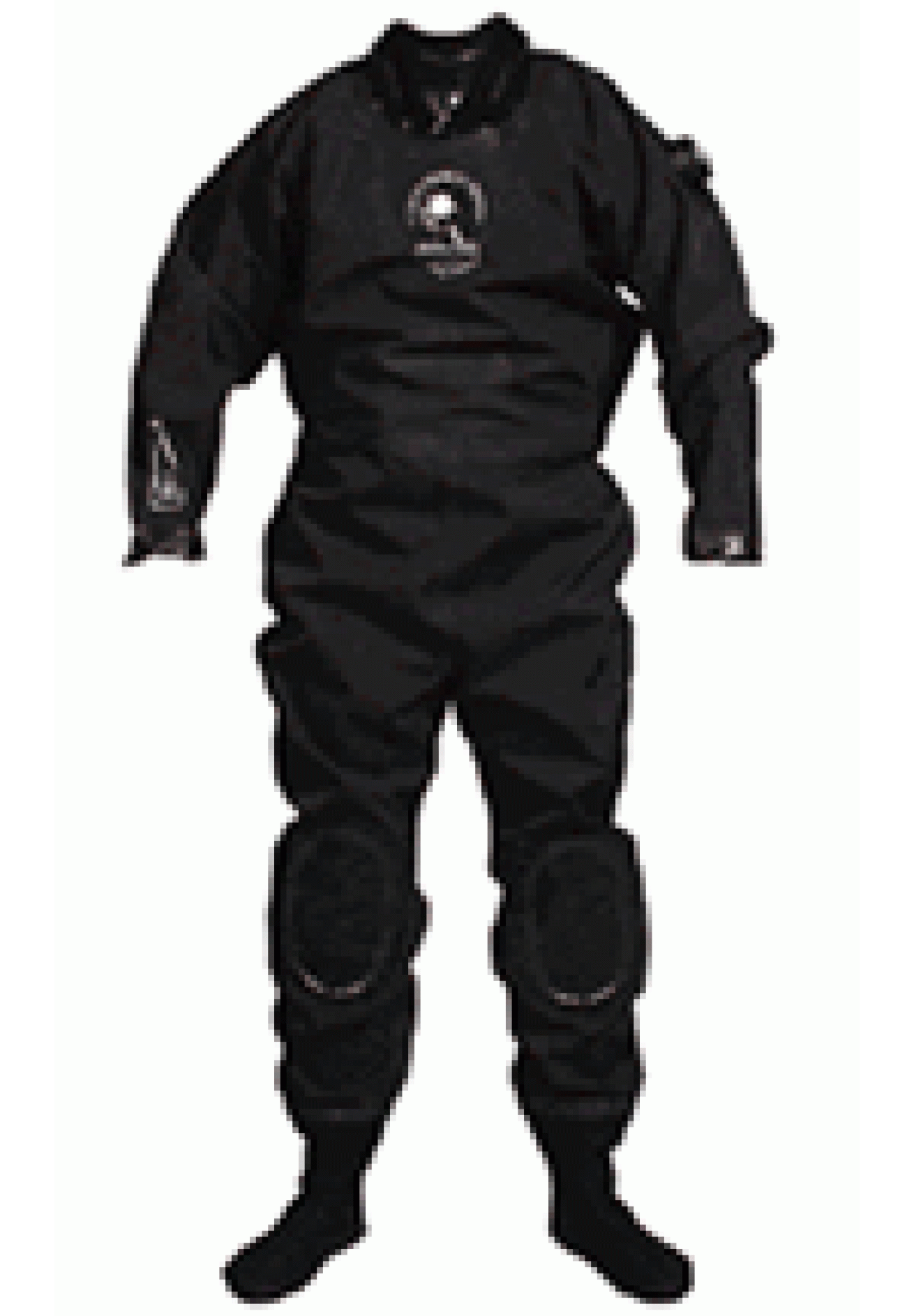
Bare's Nex-Gen Dry shell suit earned good to excellent test scores in both comfort and valve performance. A partial elastic (nonadjustable) internal waist panel improves fit; bottleneck-shaped neck and wrist seals make donning and doffing easy while keeping water out, and the attached 4mm neoprene soft socks are about as comfy as they come. All suit seams are sewn, then welded. Knees are reinforced with big 420-denier nylon patches.
The swivel inlet valve provides excellent airflow control. The exhaust valve offers two full revolutions of adjustment. It's positioned a little higher than exhaust valves on other dry suits we've reviewed, which seems to contribute
The soft socks are designed to be used with Bare's optional Trek boots. These boots are extremely flexible and provide good ankle support. While the heavy tread is designed for rocky entries as well as boat decks, we found the soles to be a little slippery on metal dive ladders. Trek boots come in black and sell for about $90 a pair.
Material: "Nex-Gen" welded fabric.
Seals: Latex.
Swivel inlet: Yes.
Color: Black.
Sizes: 9 men's, 4 women's, stock sizes only.
Price: $749.95, includes: Suit, neoprene soft socks, valves, inflator hose, knee pads, zipper lube, talc and bag.
Strengths: Easy to don and doff. Excellent valve flow rates. Good owner's manual.
Weaknesses: Trek boots slippery on metal dive ladders.
DUI TLS350SE: Comfortable and Durable
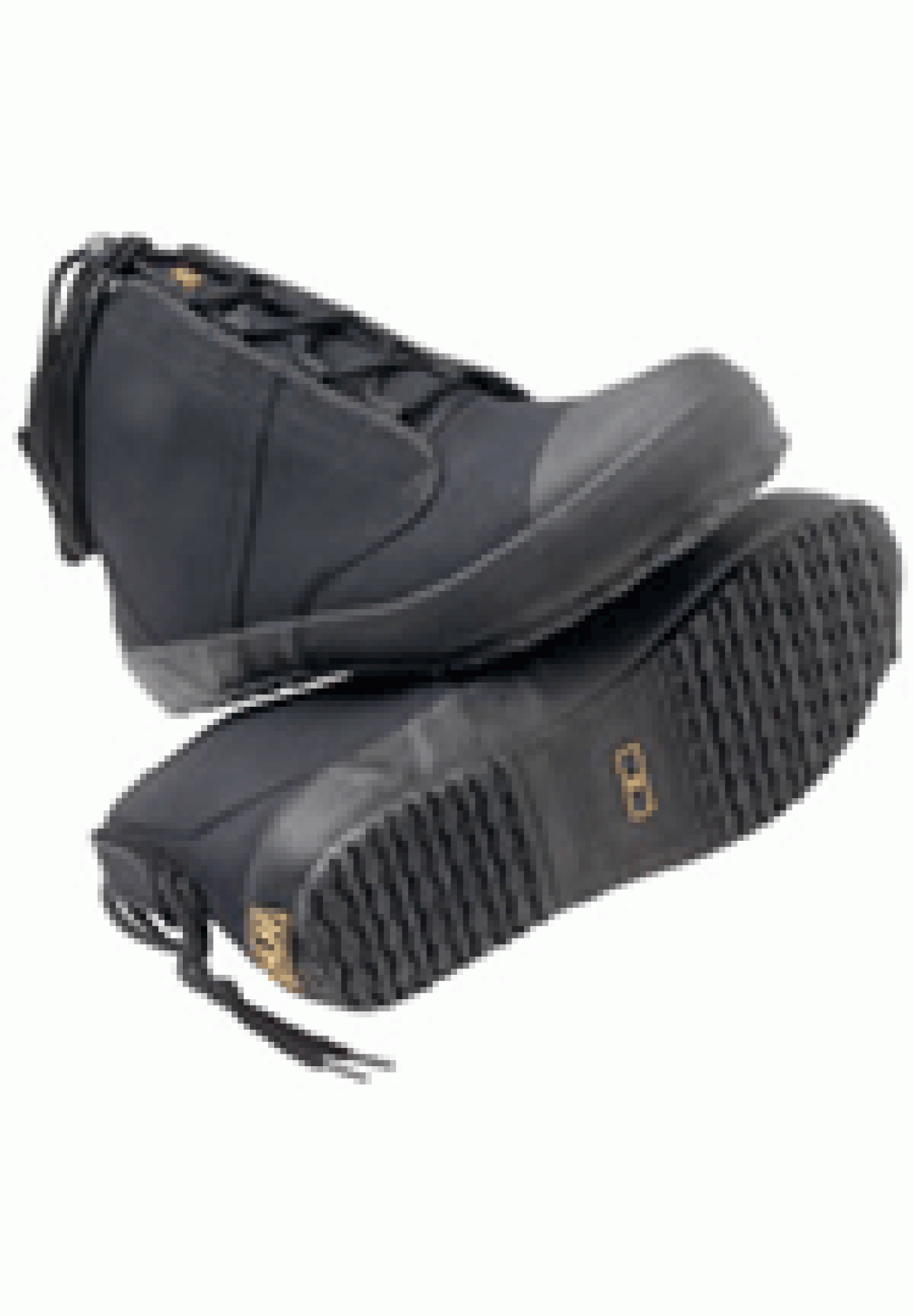
The only trilaminate dry suit in this group and deemed the favorite fabric suit among test divers, DUI's TLS350SE is extremely comfortable. The additional inner layer of nylon not only helps to protect the waterproof layer, but it creates a smooth surface that makes it easier to slip the suit over undergarments. The suit comes with an internal adjustable waist cord and an extra layer of nylon in the thigh, knee and shin areas. The attached socks are made of supple soft-dipped neoprene, enabling you to turn the suit inside out for drying. Neck and wrist seals are cone-shaped, which DUI feels will accommodate a wider range of neck and wrist sizes while still providing plenty of rubber to contact the skin for a good seal.
Both valves produce efficient air flow. The inlet valve's action allows for fine-tuning. The low-profile exhaust valve is well-positioned for automatic activation. A flanged quick-disconnect fitting on the inlet hose is easy to grip. The hose itself is about four inches longer than other dry suit hoses, which makes it easier to route.
At the price listed here, the TLS350SE comes with soft socks that can be worn inside standard (albeit oversized) dive booties. However, for a few extra bucks, the TLS350SE can be ordered with attached boots, or better yet, with DUI's separate Rock Boots. Although primarily designed for hiking over rocks to reach dive sites, these rugged boots provide ankle support as well as great traction on slippery boat decks and dive ladders. They sell for about $40.
The TLS350SE is now available in women's sizes, designed with shorter arms, narrower shoulders, a tapered waist, more hip and thigh room, and smaller feet.
Material Nylon/butyl rubber/nylon.
Seals Latex.
Swivel inlet Yes.
Colors Blue/black for men; purple/black for women.
Sizes 5 men's, 5 women's, stock sizes only.
Price $998; includes: suit, valves, inflator hose and dipped neoprene socks.
Strengths Easy to don and doff. Responsive inlet valve. Low-profile exhaust valve. Easy-to-use quick-disconnect hose fitting. Good valve flow. Excellent owner's manual.
Weaknesses None.
O.S. SYSTEMS DOLPHIN: Nice Workmanship
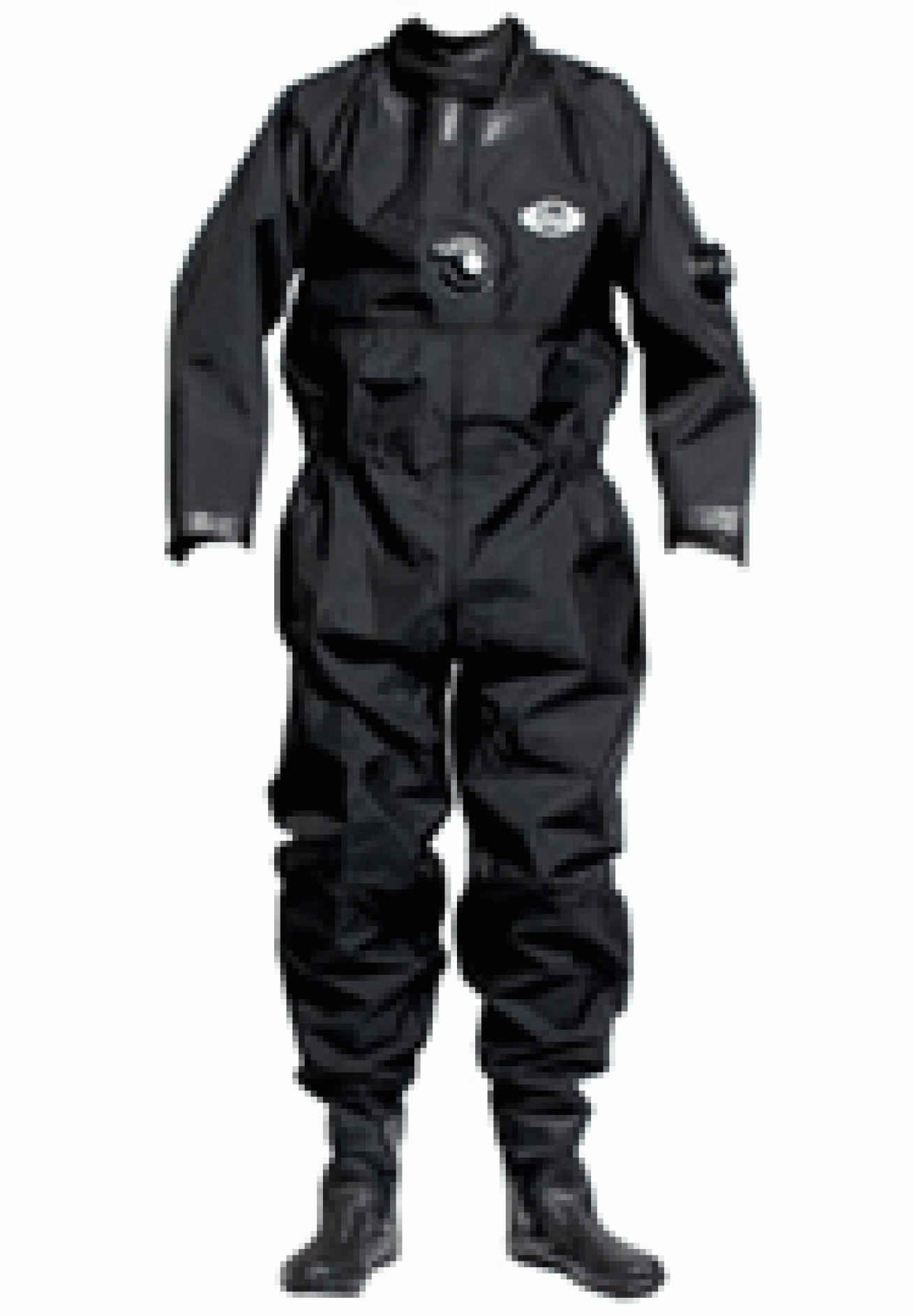
O.S. Systems' Dolphin is a well-constructed shell suit with quadruple stitching throughout and a reinforcing layer of nylon in the knee areas. Holes along the boot cuff are provided to drain water from between these "dome" knees and the suit itself. The suit is roomier than some other comparatively sized shell suits. An internal, nonadjustable waistband helps improve fit. Wrist and neck seals are bell-shaped. The Dolphin's vulcanized rubber boots are very comfortable, providing excellent flex, although they're not as rugged as other dry suit boots. They'd be fine for boat decks but probably wouldn't last long climbing over rocks.
Both inlet and exhaust valves are in optimum positions. The inlet valve swivels easily. The exhaust valve is larger than most but isn't cumbersome. The quick-disconnect hose fitting is not flanged but detaches adequately. Upgrade options are limited to footwear and valve choices. Boot sizes range from 4 to 14 and are easily interchangeable.
Material 210-denier high-count nylon.
Seals Latex.
Swivel inlet Yes.
Color Black.
Sizes 6 unisex, stock sizes only.
Price $999; includes: suit, valves, inflator hose, attached boots, zipper lube, repair patches, bag.
Strengths Easy to don and doff. No boot-top interference. Good valve position and operation. Good valve flow.
Weaknesses Owner's manual provides minimal information.
USIA AQUALITE: A Rainbow of Colors
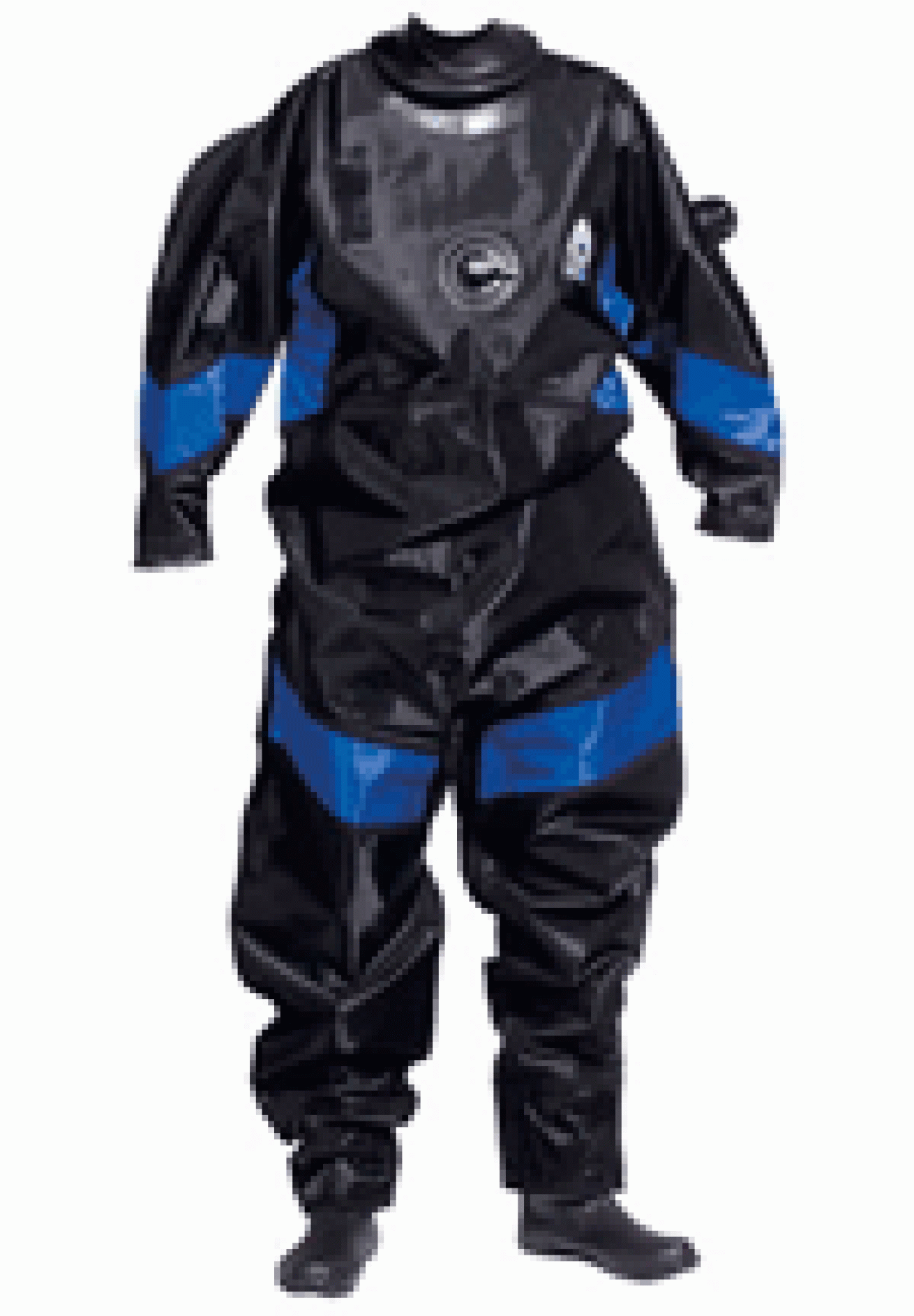
Nobody does color like USIA. Its AquaLite shell offers more accent choices than any other dry suit tested. It also provides the baggiest cut of all shell suits tested. An internal nonadjustable waistband helps rein in the additional material. Double stitching can be found along the zipper with double or triple stitching everywhere else. Soft-soled boots are standard equipment. (Sized for the U.K., they're one size larger than U.S. sizes.) They're easy to strap a fin to, but don't look like they could handle much more than a boat deck. Hard-soled boots are available as an option. All suits come with protective boot cuffs.
The inlet valve doesn't swivel, but can be repositioned by loosening then retightening the backing screw (a swivel inlet valve is available as an option for $15). The inlet valve button is hard to activate. The exhaust valve is well-positioned and flows air well. The valve is tall but dome-shaped so it's less likely to catch on gear.
With the AquaLite, you can choose among a number of packages and still stay below $1,000. For $949, you can get the suit listed above plus a neck ring, a two-sided carry bag, a maintenance kit and a pair of USIA's Exotherm I undergarments. For another $50 you get the heavier Exotherm II undergarments.
Material 210 nylon twill, urethane-backed.
Seals Latex.
Swivel inlet No.
Colors Black with blue, pink, lime, purple, yellow, teal, orange or red accents.
Sizes 7 unisex, stock sizes only.
Price $899; includes: suit, valves, inflator hose, attached boots, zipper lube.
Strengths Easy to don and doff. Good owner's manual. Good valve flow. Good valve positioning. No boot-top interference.
Weaknesses Inlet valve doesn't swivel. Stiff inlet valve action. Extra bulky fit.
WHITES NEXUS SHELL SUIT: Good Suit, Great Price
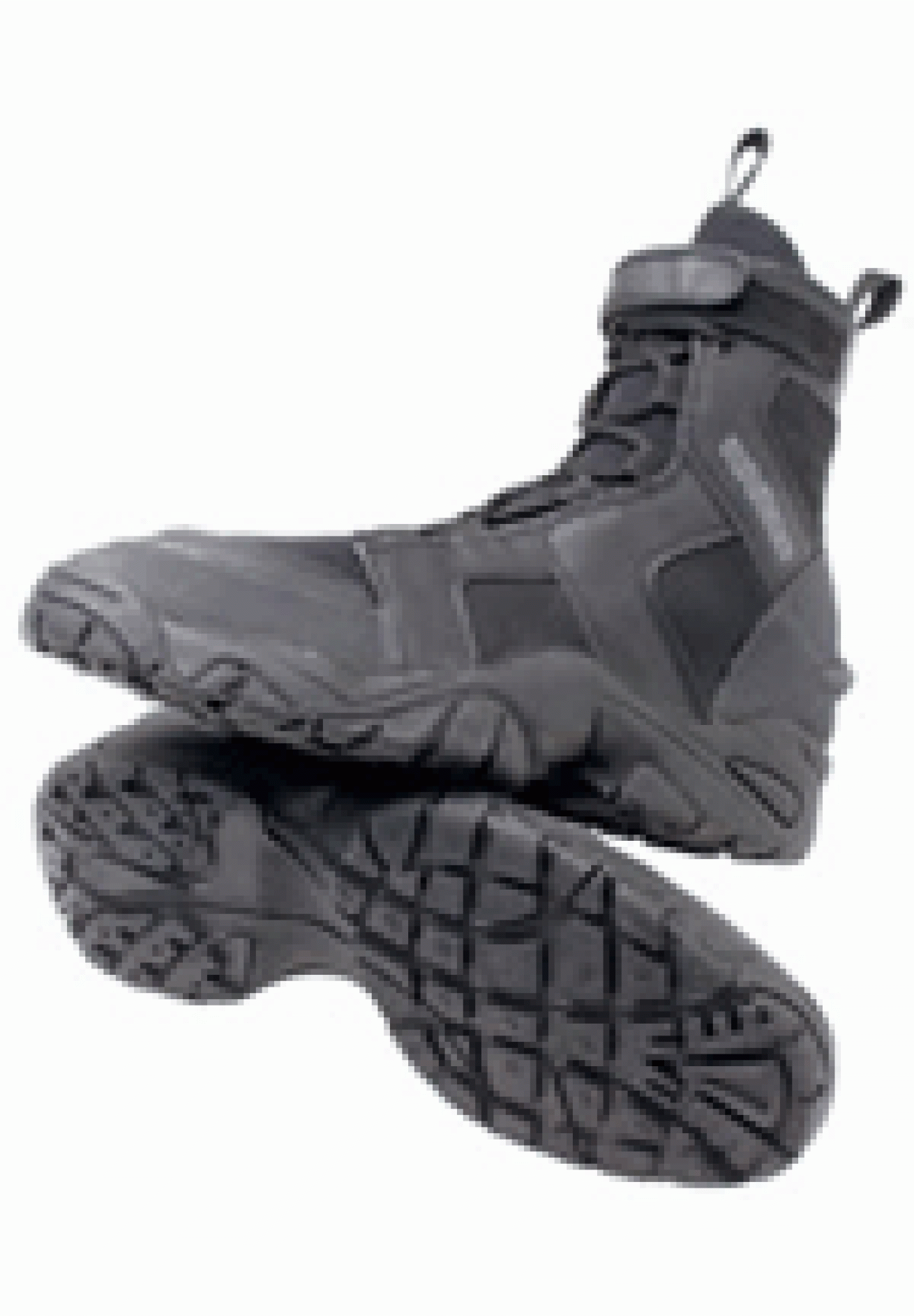
Good performance combined with the lowest price of all dry suits tested earned Whites' Nexus Shell both Testers' Choice and Best Buy designations. The suit comes with bell-shaped latex seals, bilaminate soft socks, suspenders and a partial elastic waistband. One of the best fitting shell suits, its almost tapered cut provides such a snug fit that when it comes to sizing, you'll probably want to err on the large side, especially if you normally alternate from thin to thick undergarments.
The same goes with Whites' optional Evolution boots, which are more flexible than DUI's Rock Boots and fit much easier into standard fin foot pockets. But while Rock Boots are cut big to accommodate insulated footwear and soft socks, Evolution boots are cut closer to standard shoe size. During tests, a size 10 Rock Boot was able to comfortably accommodate insulated footwear and suit socks, whereas a size 11 Evolution boot on the same foot wearing the same footwear and suit socks caused some serious toe cramping. Evolution boots cost $80 if ordered with a Nexus suit, $100 if purchased separately.
Although both inlet and exhaust valves are well positioned and operate efficiently, the fact that the inlet valve doesn't swivel is a disappointment on what is otherwise an exceptional suit. The Nexus Shell includes an ID-ROM that provides instructions on dry suit use and maintenance.
Material 420-denier bilaminate.
Seals Latex.
Swivel inlet No.
Color Black.
Sizes 12 unisex, stock sizes only.
Price $678; includes: suit, valves, inflator hose, knee pads, zipper lube, bag, instructional ID-ROM.
Strengths Low price. Lots of sizes. Easy to don and doff. Suspenders. Good valve positions and operation. Good valve flow rates.
Weaknesses Inlet valve doesn't swivel.
VIKING'S X-TREME: Built Tough
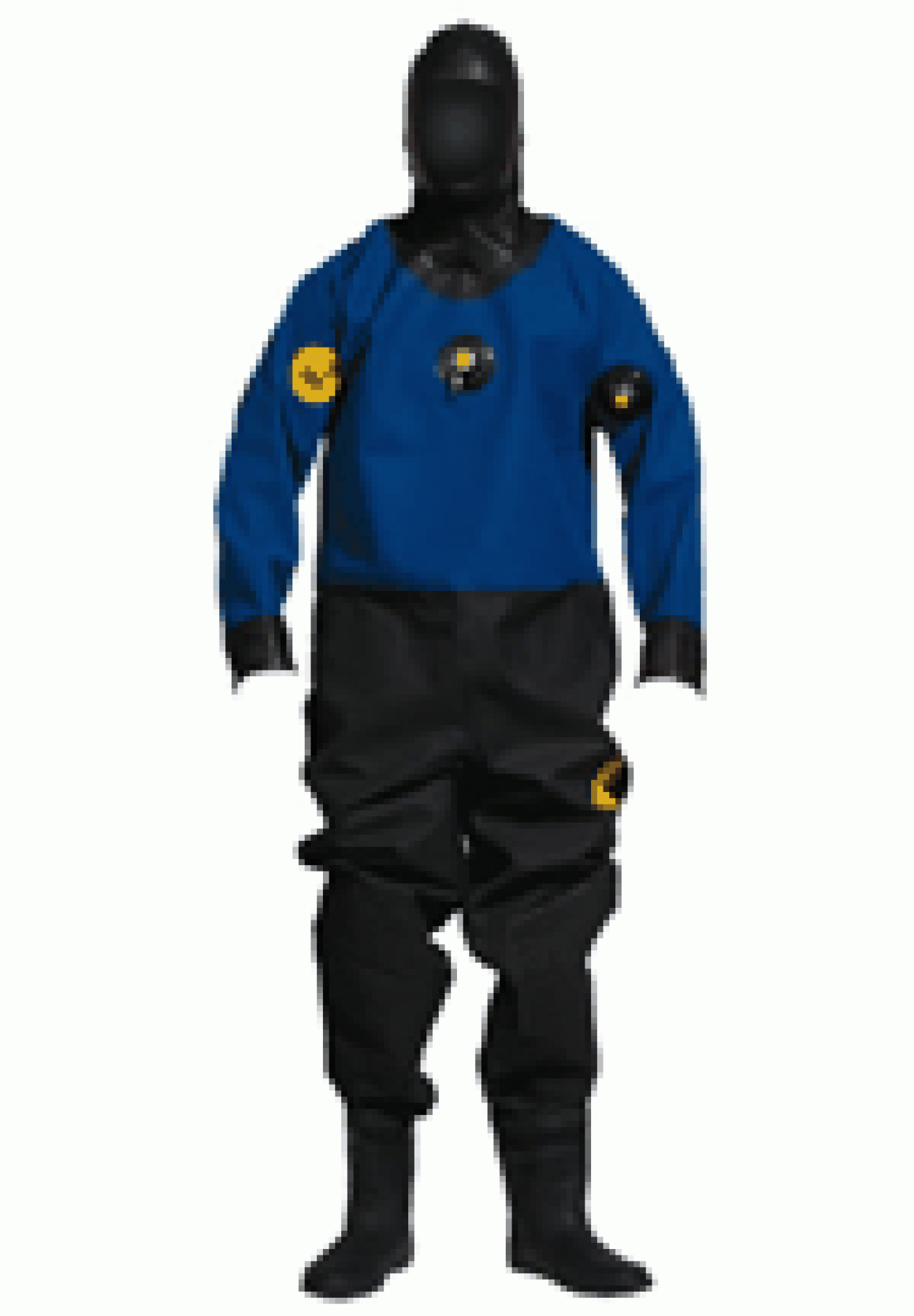
The first thing that strikes you about Viking's X-Treme is how bulletproof the suit appears. Constructed of a polymer-coated fabric with welded seams, the suit offers extra-thick cone-shaped latex seals, large heavy-duty knee pads and rugged yet very flexible chloroprene-coated boots. Suspenders are standard, a nice touch. So is the attached Surveyor hood, although this is an acquired taste. Depending on how much facial hair you have, it can be difficult to get a proper seal. Viking says the hood is available in smaller sizes to accommodate divers with smaller heads. However, the trim of the hood opening is critical to achieving seal success. Although Viking prefers selling its X-Treme with the Surveyor hood attached, you can order the suit with a latex neck seal only for the same price or with an attached neoprene hood for an additional $50.
The X-Treme's inlet valve works efficiently, but the exhaust valve needs some coaxing. The consensus during testing was that the position of the valve on the bicep makes it necessary to manipulate the valve to help it bleed air. On the other hand, the flanged quick-disconnect fitting on the inlet hose is clearly the best of the bunch. Not only is it large, making it easy to grip, but you don't have to pull back on the flange to attach hose to valve. Simply press it to the valve nipple and it snaps right on.
The X-Treme is available in "X-Treme Wide" sizes to accommodate larger chests and shoe sizes.
Material Polymer-coated fabric.
Seals Latex.
Swivel inlet Yes.
Colors Black, blue/black. Sizes 5 unisex, "wide" sizes available.
Price $950; includes: suit, valves, inflator hose, suspenders, attached hood, attached boots, repair kit, bag.
Strengths Excellent hose quick-disconnect. Good inlet positioning and operation. Removable suspenders. Excellent owner's manual.
Weaknesses Exhaust valve position and operation. Difficult to achieve hood seal. {mospagebreak}HYPERCOMPRESSED NEOPRENE DRY SUITS
DUI CNSE: Leader of the Pack
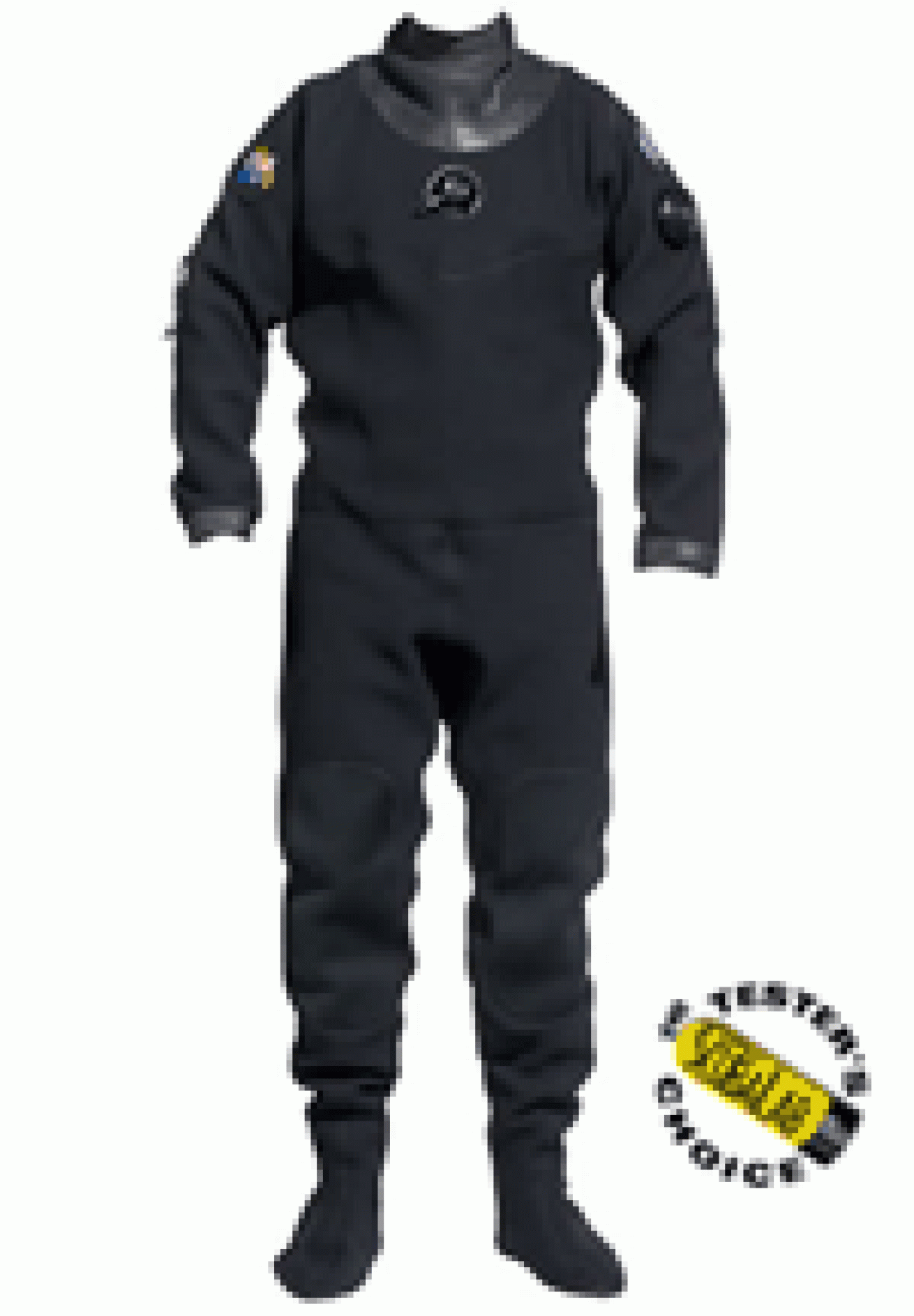
The overall favorite dry suit among Scuba Lab's test team, DUI's CNSE falls into a category of its own. Constructed of heavy-duty nylon over 1.5mm hypercompressed (not crushed) neoprene, the CNSE not only fits like a glove, but it provides more stretch than fabric suits while sidestepping the buoyancy problems of traditional foam neoprene suits. It's an extremely comfortable suit that comes with an internal adjustable waist cord that improves upon an already snug fit. A pair of beefy knee pads provide additional protection for the bottom scratchers among us.
Like its cousin the TLS350SE, the CNSE's valves are well-positioned on the chest and upper arm. The inlet valve delivers smooth action while the exhaust valve's low profile makes it easier to slip under BC straps. The suit comes with an extra-long inlet hose equipped with an easy-to-use quick-disconnect fitting and is designed to be worn with DUI's optional Rock Boots (see "TLS350SE").
Both the CNSE and the TLS350SE come with what's arguably the most comprehensive dry suit owner's manual in the industry. These consumer-oriented manuals are not only invaluable for DUI dry suits, but the information and instructions on boot use, valve maintenance and general dry suit diving techniques can easily be applied to any dry suit or dry suit diving situation.
Material Hypercompressed neoprene.
Seals Latex.
Swivel inlet Yes.
Color Black. Sizes 5, stock sizes only.
Price $998; includes: suit, valves, inflator hose, knee pads, dipped neoprene socks.
Strengths Easy to don and doff. Pliable material. Responsive inlet valve. Low-profile exhaust valve. Easy-to-use quick-disconnect hose fitting. Good valve flow. Excellent owner's manual.
Weaknesses None.
FOAM NEOPRENE DRY SUITS
BARE SPORTSWEAR D7 SUPRA DRY: Sizes Galore
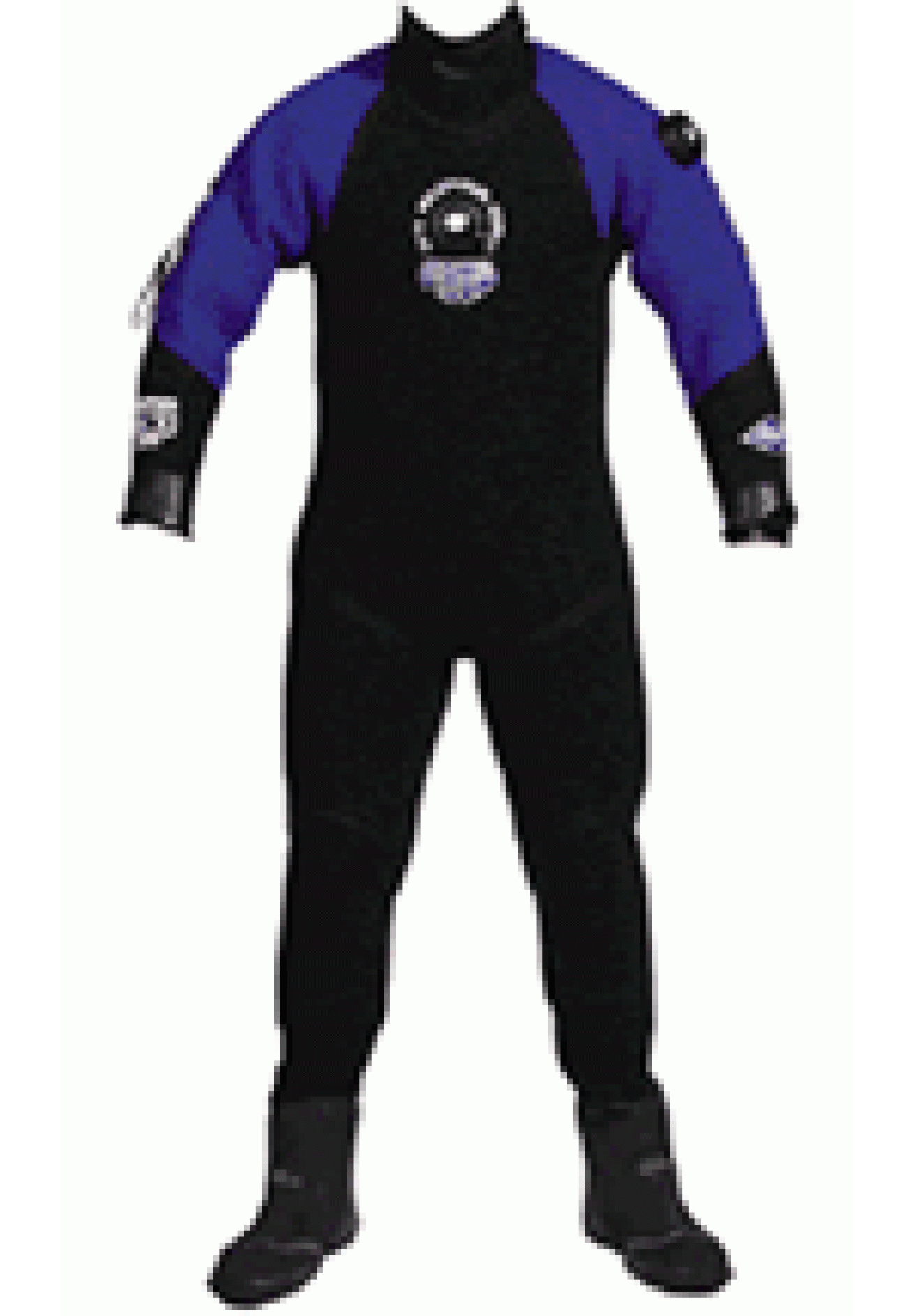
The D7 Supra Dry is available in six stock sizes, but if you can wait a few weeks for delivery, you can increase your choice of sizes more than twofold. The suit's 6mm "high density" neoprene is sandwiched between Diamond Tuff nylon and a "heat-reflective" Metalite lining. All seams are double-glued and heat-taped. Both inlet and exhaust valves produce efficient airflow.
The test suit was delivered with reinforced knee pads and attached vulcanized 7mm neoprene boots that are rugged but surprisingly flexible. However, those who prefer separate boots can order the suit with attached soft socks and Bare's Trek boots.
The D7 Supra Dry is the only foam neoprene dry suit recently tested with bottleneck-shaped latex wrist seals. The latex is very thick and doesn't stretch much, but with proper trim and the help of talc, it provides a relatively comfortable watertight seal. The extra-long neoprene neck seal allows for a fold-over skin-in seal but bulks up the neck area, creating a fit that's not as comfortable as previously tested neoprene dry suits. A cold-water collar is standard.
Material: 6mm neoprene/nylon.
Seals: Neck, 3mm neoprene; wrists, latex.
Swivel inlet: Yes.
Colors: Blue/black.
Sizes: 6 men's, 4 women's, custom sizing available.
Price: $899.95; includes: Suit, valves, inflator hose, attached boots, knee pads, zipper lube and talc.
Strengths: 15 semi-custom sizes. Highly adjustable exhaust valve. Heavy-duty attached boots. Good owner's manual.
Weaknesses: Uncomfortable neck seal design.
HENDERSON ARCTIC DRY II: Super Stretch
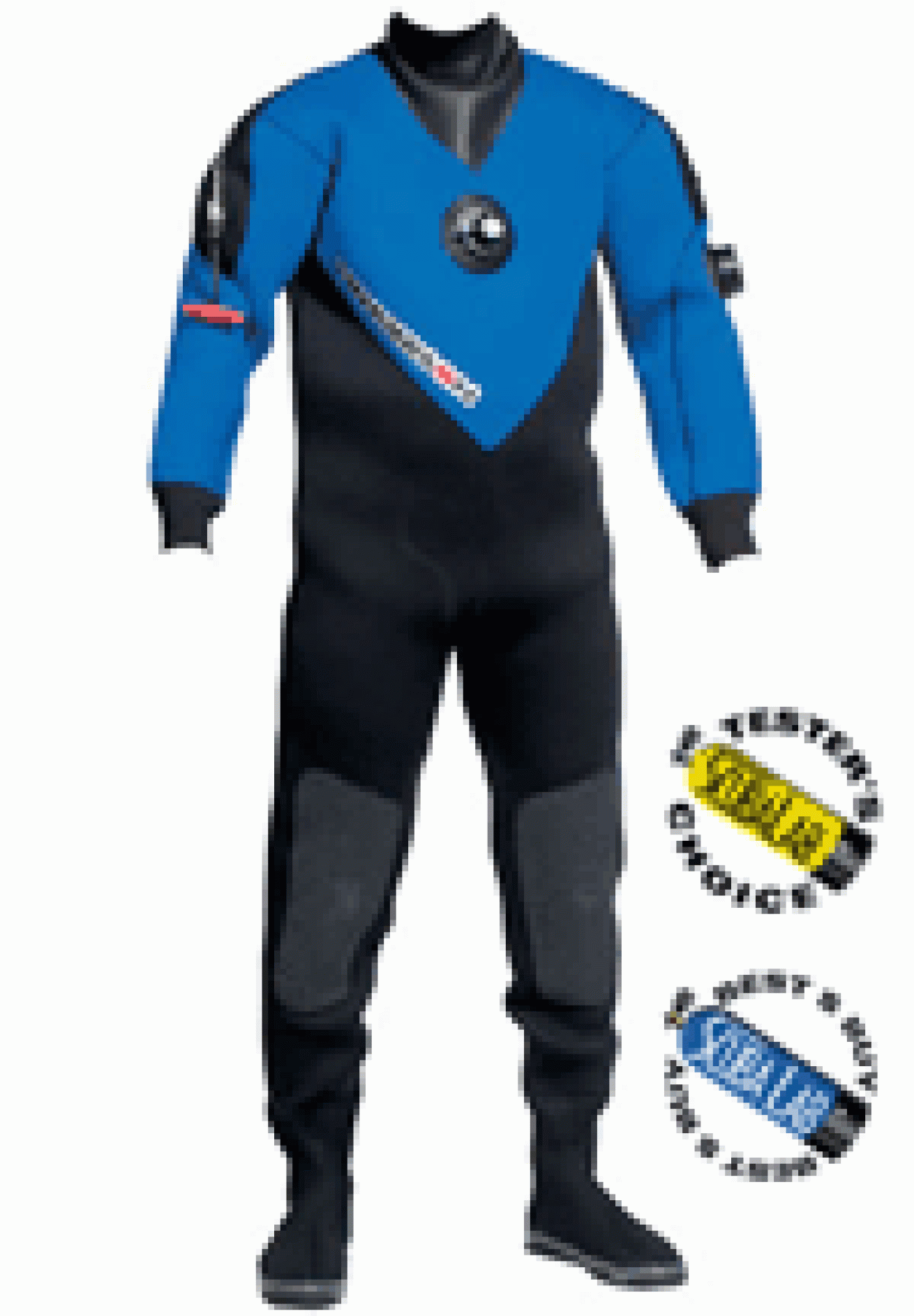
In last year's dry suit reviews, Henderson's Arctic Dry II foam neoprene dry suit earned a Best Buy designation for its great price. This year, a new swivel inlet valve and a low-profile exhaust valve contributed to the Arctic Dry II also being named a Testers' Choice.
Thanks to its stretch and range of motion, this comfortable suit was repeatedly compared by testers to wearing a wetsuit. Ankles are tapered, and the soft boot uppers combined with a hard sole create a snug boot with lots of flexibility and less stiff rubber to stuff into a fin pocket. The Kevlar knee pads are excellent, and the wrist seals are neoprene out/skin in, eliminating the need to fold them over to attain a seal.
Just like wetsuits, neoprene dry suits can be difficult to climb in and out of. Because of its flexibility, the Arctic Dry II is easier to don and doff than most other neoprene suits, especially when a splash of unscented talcum powder is applied to the skin-in seals.
Valve flow on the Arctic Dry II is very good. The inlet provides efficient air control and the exhaust valve dumps air fast. Henderson has dropped separate women's sizes for 2002.
Material 7mm foam neoprene.
Seals Neoprene.
Swivel inlet Yes.
Colors Blue/black. Sizes 6 unisex, stock sizes only.
Price $729; includes: suit, valves, inflator hose, knee pads, attached boots.
Strengths Low price. Flexible body. Soft boot uppers with heavy-duty soles. No boot-top interference. Good valve flow. Good owner's manual.
Weaknesses None.
OCEANER HORIZON: Special Orders Don't Upset Us
The little touches stand out on Oceaner's Horizon neoprene dry suit, like oversized knee pads and a protective cap on the inlet valve. Inner seams are heat-sealed and pressure-taped; outer seams are glued and blind-stitched. Shoulders are cut on a contour to conform better to a diver's shape.
Without a doubt, the Horizon is a comfortable dry suit. The vulcanized rubber boots are easy to get in and out of, yet create no boot-top interference. However, the Horizon carries more inherent buoyancy than other neoprene dry suits we've tested. All test divers had to carry a couple extra pounds of ballast to stay neutral. Also, due to the zipper's lay along the shoulders, the exhaust valve is positioned off the top of the upper arm, although it doesn't appear to affect overall valve flow.
Of course, valve placement is optional, as is boot sizing, wrist and neck sizing, and seal type. In fact, Oceaner is willing to make any kind of adjustment you want, all at no extra charge, if you're willing to wait a little longer to get your suit (usually from five to 21 days, depending upon what you want and the season).
Material: 7mm foam neoprene/nylon II.
Seals: Neck, 3mm neoprene; wrists, 7mm neoprene.
Swivel inlet: Yes.
Colors: Blue/black.
Sizes: 6 unisex, custom sizing available.
Price: $749; includes: Suit, valves, inflator hose, attached boots, knee pads and zipper lube.
Strengths: Good inlet valve position. Good valve flow. Adequate owner's manual.
Weaknesses: Poor deflator valve position. Above-average inherent buoyancy.
OCEANER TITANIUM POLAR: Loaded with Extras
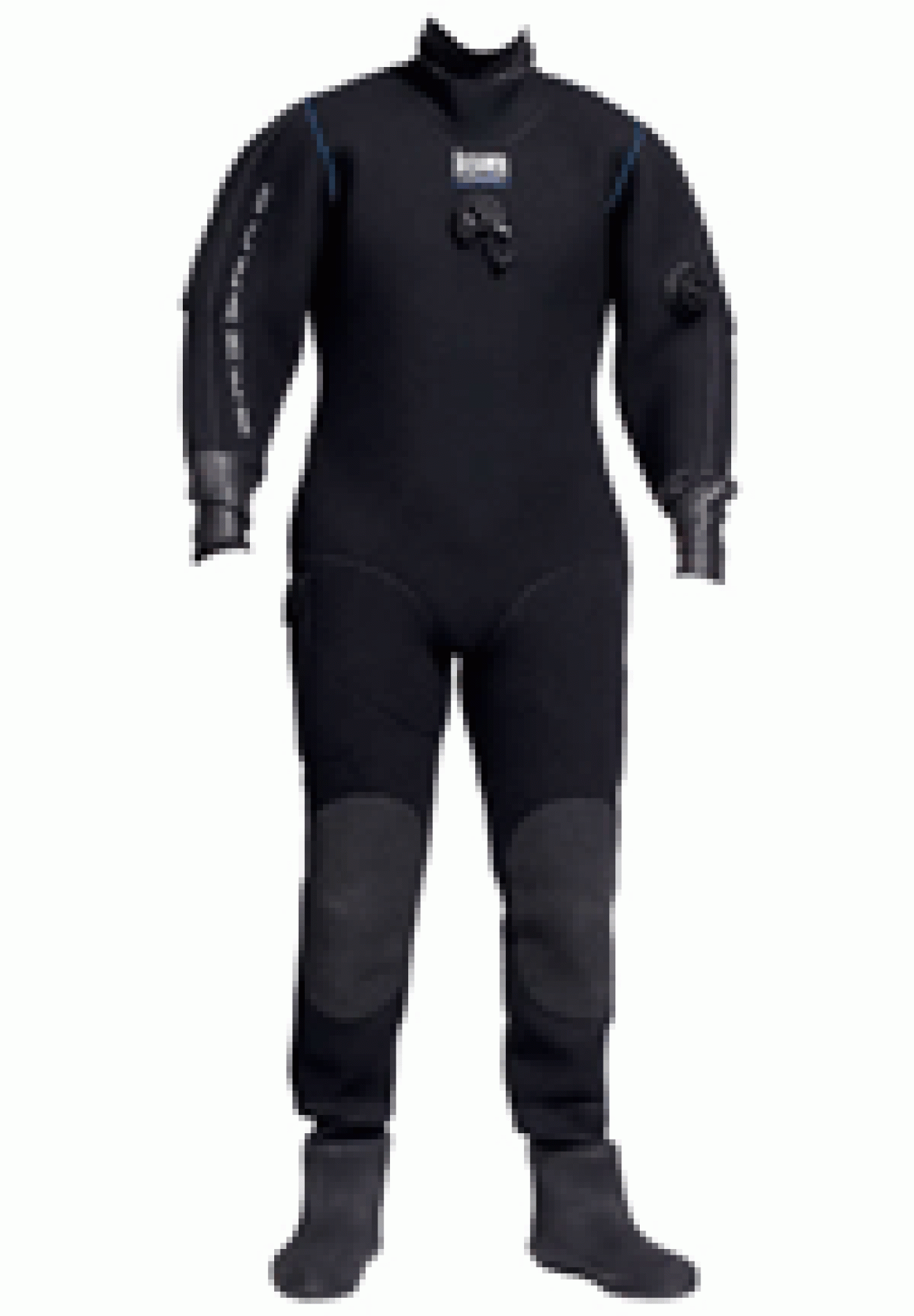
The little touches are what stand out on Oceaner's Titanium Polar dry suit.
Wrist seals are extra-long to attain proper fold-under seals. Vulcanized rubber knee pads are oversized, and there's even a protective rubber cap on the inlet valve. The suit comes standard with internal and external zipper flaps and a large thigh pocket with Velcro flap. The vulcanized rubber boots are rugged but still flexible. They're easy to get in and out of and create no boot-top interference.
The dry suit offers a titanium layer that Oceaner claims increases warmth with less body energy expended. While the increased warmth generated by titanium remains an area of contention (see RSD, April 2001), the cold-water collar and pocket are nice. So are the zipper flaps when they cooperate and stay in place.
The Titanium Polar is more buoyant than other neoprene dry suits, requiring a couple more pounds of lead to maintain neutral buoyancy. And due to the zipper's lay along the shoulders, the valve is placed not on the top of the upper arm but farther forward. This creates a somewhat awkward exhaust system, although it doesn't seem to affect valve flow.
Oceaner also makes a Horizon neoprene dry suit without the titanium layer and fewer features for about $250 less.
Material 7mm foam neoprene with titanium layer and heavy weave nylon II.
Seals Neck, 3mm neoprene; wrist, 7mm neoprene.
Swivel inlet Yes.
Colors Black, blue/black.
Sizes 6 unisex, custom sizing available.
Price $995; includes: suit, valves, inflator hose, attached boots, knee pads, zipper lube, bag.
Strengths Good inlet valve position. Good boots, no boot-top interference. Good owner's manual.
Weaknesses Exhaust valve position. Above-average inherent buoyancy.
O'NEILL 7000X: Most Like a Wetsuit
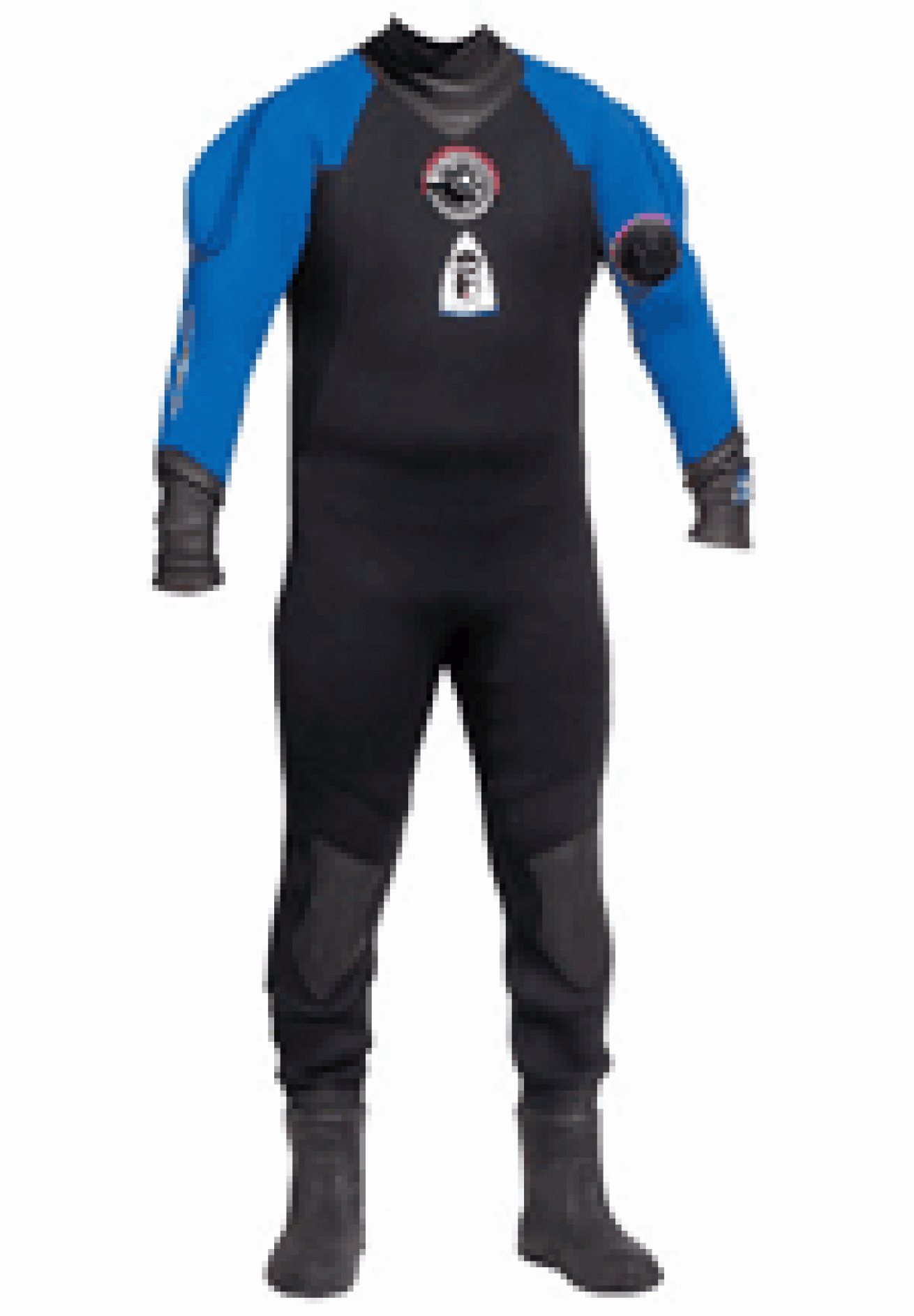
When compared to the other foam neoprene dry suits tested, O'Neill's 7000X feels most like a wetsuit in comfort and flexibility. And like a wetsuit, it's also harder to don and doff. The 7000X is available in a variety of suit and boot sizes, including custom fits. Its vulcanized boots are the most rugged of all neoprene suits tested, although they tend to be a bit stiff in the ankle area.
The 7000X's inlet valve does not swivel, so you have to loosen the backing screw to position the valve for optimum hose travel. The supplied low-pressure hose is a bit longer than average, good for routing from first stage to inlet valve.
Although the inlet valve earned high marks for both position and operation, the exhaust valve is positioned more toward the bicep than the top of the upper arm, which was found to be awkward. Around each valve, O'Neill has stamped a reminder to hand-tighten valves before each dive. This advice was followed during the tests, especially after repositioning the inlet valve. In spite of this, both valves seeped at depth.
Material 7mm Spectra neoprene body.
Seals 7mm Spectra SL cuffs and neck.
Swivel inlet No.
Colors Black, blue/black.
Sizes 9 men's, 5 women's, custom sizing available.
Price $799.95; includes: suit, valves, inflator hose, attached boots, knee pads, zipper lube, bag.
Strengths Lots of sizes. Good inlet valve action.
Weaknesses Hard to don and doff. Inlet doesn't swivel. Awkward exhaust valve position. Valves seep. No owner's manual.
WHITES NEXUS NEOPRENE: Rugged Comfort
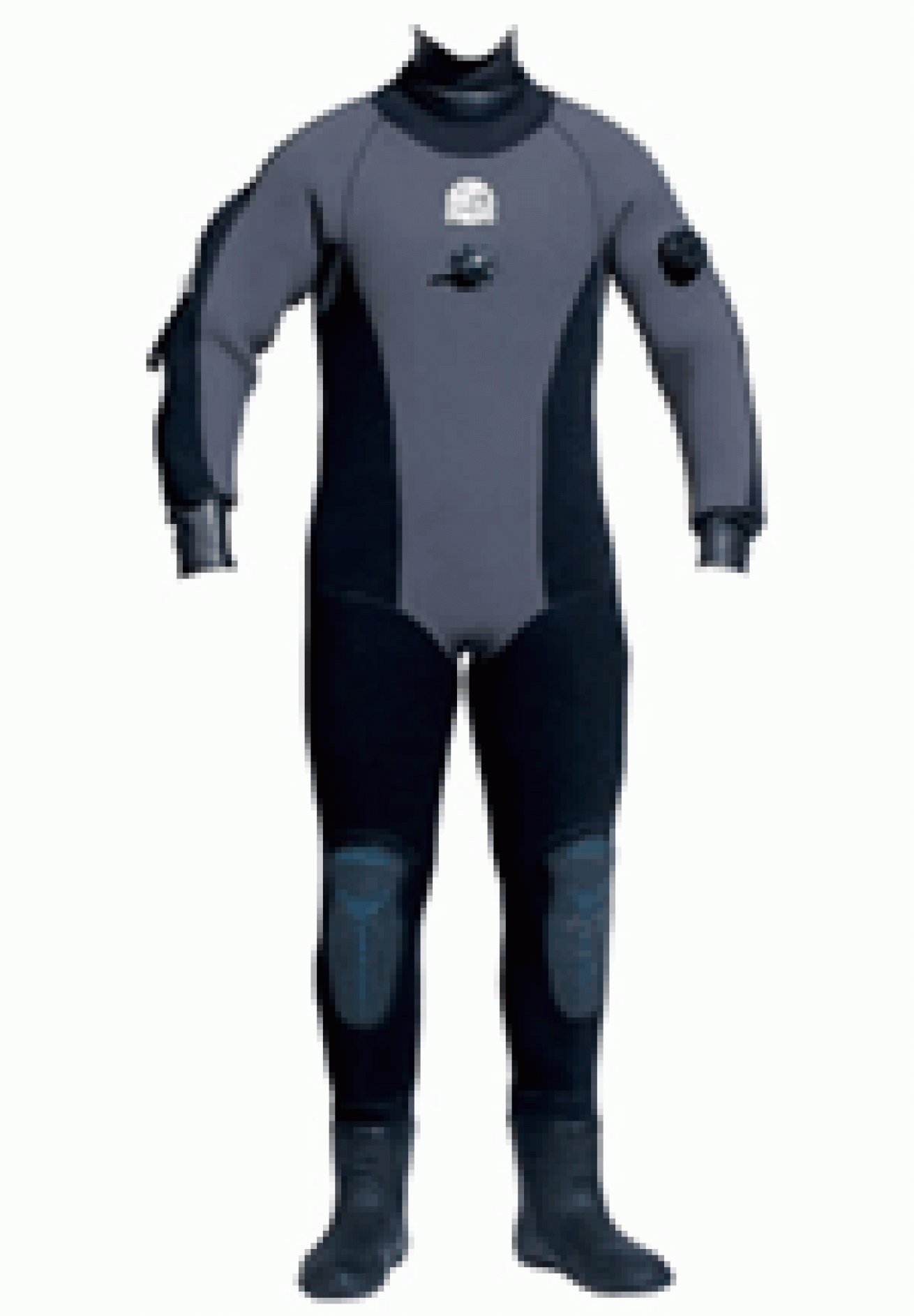
The Nexus Neoprene from Whites is available in stock sizes only, but with so many choices, you can get surprisingly close to a custom fit while enjoying stock suit prices.
Constructed of semicompressed neoprene sandwiched between a layer of titanium and abrasion-resistant nylon, this suit was considered to be the most rugged, and among the most comfortable, of the neoprene dry suits tested. Boots are vulcanized rubber with neoprene insulation. A cold-water collar is standard, as are heavy-duty knee pads. However, the wrist seals are on the short side when you consider you need to fold the cuff under to achieve a good seal.
Having a nonswiveling inlet valve is a real aggravation on a suit with so much going for it. Sure, the valve can be repositioned to accommodate hose travel, but you need to loosen then retighten the backing screw cap, which can cause the valve to seep while at depth. The exhaust valve is positioned off the top of the arm, but this didn't seem to adversely affect valve flow.
The Nexus Neoprene comes with an ID-ROM that provides instructions on how to properly use and maintain the suit.
Material 6mm semicompressed neoprene.
Seals 3mm neoprene.
Swivel inlet No.
Colors Black/charcoal.
Sizes 11 men's, 6 women's, stock sizes only.
Price $798; includes: suit, valves, inflator hose, knee pads, attached boots, zipper lube, bag, ID-ROM.
Strengths Lots of sizes. Good inlet valve position and operation. No boot-top interference. Good valve flow rates. Good owner's manual.
Weaknesses Inlet valve doesn't swivel.
Dry Suit Warranties: Are You Covered?
The following warranty information is taken directly from dry suit owner's manuals.
DUI: One year on materials and workmanship on the suit. Ninety days on neck and wrist seals.
Henderson: One year on materials and workmanship on the suit. Ninety days on neck and wrist seals.
Oceaner: Lifetime on workmanship. One year limited on materials. Sixty days on zippers.
O'Neill: Limited one year, excluding zipper.
O.S. Systems: One year on workmanship and sewn seam construction.
USIA: Five years on seams. Six months on latex components, including hoods, wrist seals, neck seals, sock or boots. Sixty days on zippers.
Viking: One year warranty.
Whites: Two years on workmanship. One year on material.
For More Information
DUI (800)-325-8439 www.DUI-Online.com
Henderson (856)-825-4771 www.hendersonusa.com
Oceaner (604)-273-0030 www.oceaner.com
O'Neill (800)-538-0764 www.oneill.com
O.S. Systems (503)-543-3126 www.ossystems.com
USIA (800)-247-8070 www.usia.com
Viking (800)-344-4458 www.trelleborg.com/protective
Whites (250)-652-8554 www.whitescoldwater.com

